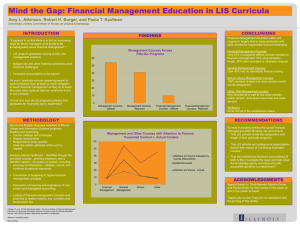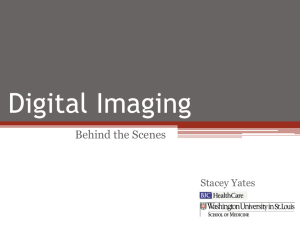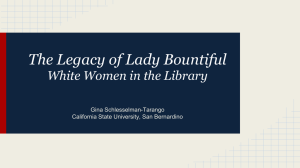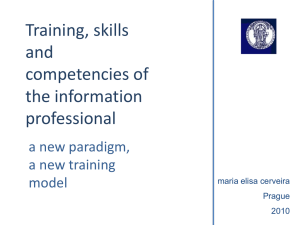Lab Work
advertisement
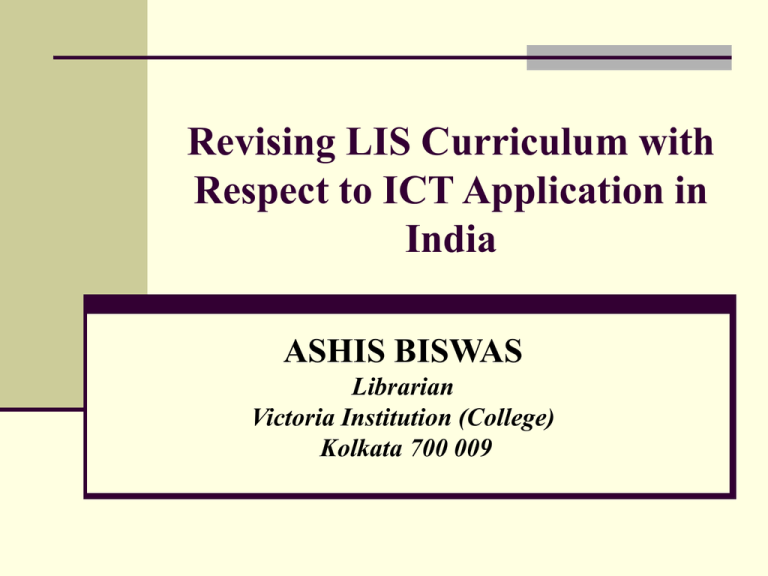
Revising LIS Curriculum with Respect to ICT Application in India ASHIS BISWAS Librarian Victoria Institution (College) Kolkata 700 009 Introduction ICT has changed our life and work or rather our way of looking and taking things altogether and perhaps for good. Higher education is no exception. Today LIS professionals play a crucial role in the society in spreading not only the repertoire of past and present knowledge but also helps to gain an understanding about what is going to happen in the knowledge frontier in time to come. It has been necessary for the LIS professionals to have a thorough insight into all techniques of information handling with special emphasis on the application of ICT & web technologies in order to design, implement, operate and manage information system. If all these concepts are included in the BLIS & MLIS courses then there will be no need to opt for any other computer courses (e.g. PGDLAN) separately. Scope of the Study For our work, we have taken the first three ranked LIS schools according to US News and World Report 2009. These are Graduate School of Library and Information Science, University of Illinois; School of Library and Information Science, University of North Carolina and School of Information studies, Syracuse University. We have analyzed their various course contents to find out the ICT contents and the respective papers. According to University guide 2010 of The Guardian under the subjects Media studies, communications and librarianship, University of Sheffield and Loughborough University are the top two ranked LIS School in UK. For Indian perspective we took some well known LIS Schools/ Department for our study. These are Calcutta University, Burdwan University, DRTC, IGNOU, NISCAIR, Banaras Hindu University, Delhi University etc. To make our study more comprehensive we have also checked the UGC model curriculum in LIS. After analyzing these courses and their ICT contents, we have tried to propose the best possible way to teach different areas of ICT at various LIS courses at various levels such as graduate or postgraduate levels at different universities in India. Objectives To show the integration of ICT & web technologies in the LIS syllabi to meet the present requirement. To propose the restructuring of LIS courses to integrate the ICT and web technologies LIS Curriculum : India The typical course content at the BLIS level would be: Library and Society Classification (Theory and Practice) Cataloguing (Theory and Practice) Library Organization Information Sources and Services With optional papers from: Information Retrieval Techniques Management of Library Services Computer Applications in Libraries MLIS Programme Common papers include : Information and Communication Process/Society Library and Information Management Information Sources, Systems and Services Research Methodology Application of information Technology Information Storage and Retrieval (ISAR) (Theory) Information Storage and Retrieval (ISAR) (Practical) With optional papers from Preservation and Conservation of Library Materials Industrial/ Agricultural/ Health /Engineering /Research & Technical/ Public/ Academic/ Library and Information System and Services Community Information System and Services Technical writing Scientometrics and Informetrics Knowledge Management LIS Curriculum : UK The compulsory modules at the Masters level invariably include: Information: Characteristics/use/ requirements Information Policy Information Sources, Organisation and retrieval Development of Information Products and Services With optional papers from Knowledge Management Database Management system Digital Libraries University of Sheffield and Loughborough University Computer Systems Database Design Operating Systems, Network and the Internet Electronic Publishing LIS Curriculum : USA The Life Cycle of Information Information Behavior Information Resources, Services and Collections Organization of Information and Resources Information in Social Context Instructional and Training Strategies for Information Professionals Research Methods and Statistics Management of Information Organizations Marketing of Information Univ. of North Carolina, Univ. of Illinois and Syracuse University Information Technology and Organizations Human Interaction with Computers Database Development & Management Internet & Network management Digital Libraries: Principles and Applications Need for Curriculum Revision Library and information professionals are increasingly working in a networked environment, dealing with library automation packages and web based information resources and services. Every LIS professionals irrespective of his future place of work must have knowledge and skills for handling information technology and the competency for creation and collection of information using the internet. Contd… But LIS schools in India are not able to adequately respond to emerging information scenario created by electronic publishing and dynamics of the knowledge society. Because of lack of adequate faculty strength several library schools are letting the courses go on as they are going on. The course revisions if any are undertaken with some patches here and there, whereas the present courses are required to be completely redefined and recasted keeping in view the contemporary information systems, global technological developments and local needs. Integration of ICT & Web Technologies in LIS Syllabus Paper-1: Fundamentals of IT UNIT1 - Computer Hardware and Software Basics: Von Neumann Architecture, Computer Generations, Classification of Computers, Computer Organisation Data Representation: ASCII, BCD, UNICODE & Numbering systems (Binary, Octal, Hexadecimal) Processor Types: CISC, RISC File Formats: Image, audio, video, text Memory Hierarchy: Register, Cache, RAM, ROM, DRAM, Flash Memory Secondary Storage: Characteristic of Hard disk and CD-ROM, DVDs, Pen Drives, Cartridge Tape Drives etc. IDE, SCSI Interfaces Printers: Types and characteristics Scanners: Types and Characteristics Paper – 1 (contd…) UNIT 2 – Operating System (OS) Types of OS: Serial Processing, Batch processing, Multiprogramming OS, Distributed OS and Network Operating System File Systems: FAT, NTFS, UNIX File system Lab Work MS Windows: Installation and configuration of Windows, application, device drivers, printers, creating users and groups, file sharing, system settings Microsoft Office: Word, Excel, PowerPoint Paper-2 : Programming, DBMS and SQL UNIT 1 – Principles of Programming Generations of languages, Assemblers, Interpreters and Compilers Algorithms, Flowcharts, Pseudo Codes Centralised processing and Client Server architecture, Ntier Architecture Software Development Life Cycle Paper – 2 (contd…) UNIT 2 – DBMS Introduction File based systems and their limitations DB approach, database models Architecture Three level architecture of DBMS Elements of DBMS: Host language interface, precompiler, DDL, DML, File manager, DB manager, DB Administration, Data dictionary, Data files and indexes Entities, attributes, relationships, ER diagram Relation model: Domains, attributes, tuple, relations Keys: Primary keys, foreign keys, indexes Conversion of ER diagram to relational database Normalization: 1NF, 2NF, 3NF, BCNF Paper – 2 (contd…) UNIT3 – Structured Query Language CREATE, SELECT, INSERT, UPDATE, DELETE, GRANTING PERMISSIONS, VIEWS, CURSORS, TRIGGERS Lab Work MYSQL/SQL Server : Installation and configuration of MYSQL/SQL server, database design and creation, SQL commands, Assigning roles and Permissions to users, Functions, Indexing Paper – 3: Library Automation and Fundamentals of Internet UNIT 1 – Library Automation Basics : Library automation software, OPAC, Retrospective Conversion Techniques Automating Identification Methods : Bar coding, RFID Selection criteria for hardware and software Library Automation Software : WINSIS, JAVAISIS, WWISIS, SOUL, LIBSYS, Paper – 3 (contd…) UNIT 2 – Fundamentals of Internet Introduction to computer Networks, uses Classification Intra-net, Extra-net Networking Models Model Network Topologies : LAN, MAN, WAN: Internet, : ISO OSI, TCP/IP reference : Bus, Ring, Star, Mesh Lab Work In hand practice of Library Software, Creating OPAC and Retrospective conversion of data, Use of Barcode. Paper -4: Digital Libraries and Digital Preservation UNIT 1 – Digital Libraries Overview of Digital Library Definition, Need for a digital library, Types Components of a digital library – Collection, network, organization, browsing and interfaces Advantages and limitations Digitization and Tools Techniques of digitization, resolution, imaging Formats Character sets such as Unicode Files and Formats of documents, images, video, audio, etc Conversion from one format to another Usage of XML Metadata Role of metadata and metadata types; Standards (Dublin-core) Digital Library Software D-Space, Greenstone etc Paper – 4 (contd…) UNIT 2 – Digital Preservation Overview, Need, challenges, DP strategy – migration, replication, computer archeology, standards, Universal virtual computers, DP metadata and Institutional Repositories. Creation of Digital Libraries Process of planning, creating and managing a digital library Lab Work Installation, configuration and working in of Greenstone/D-space. Paper -5: Internet Concepts, Resources and Services UNIT 1 – Fundamentals of Networking Switching Techniques Network Devices Network connectivity Network Addressing Protocols and Services Network Security : Circuit Switching, Packet Switching : NIC, Modem, Amplifier, Repeater, Hub, Bridge, switches, Router, Wi-Fi devices : Dial-up, Leased Line, ISDN, RF etc. : MAC address, port address, Domain address, IP address : IP, TCP, DNS, SMTP, PoP, FTP, Telnet, HTTP, search Engine, Proxy, Firewall, Web server : Authentication, Firewall, IDS, Virus, Spywares, Maintenance Paper – 5 (contd…) UNIT 2 – Resources Search Engines Searching Techniques Evaluation : Introduction, categories: Primary, Meta, specialized Search Engines, hybrid, subject gateways, Directories, Open source software: concepts, Licensing : Basic search, Advanced search: Boolean operators, Proximity operators, wild cards, phrases : Capabilities: Search Results, Relevance ranking UNIT 3 – Services World Wide web, web servers, Proxy Servers, Domain name Servers, Email, Conferencing: Audio and Video, Chat & instant message, User Groups, Discussion Board, Bulletin Board Paper – 5 (contd…) UNIT 4 – Web 2.0 & Web 3.0 Technologies UNIT 5 – Website Development Introduction, Principles of Web design, software Tools, Markup Language: HTML, DHTML, XML: Syntax & commands, Text, tables, Images, Links, Frames, Style sheet and layering. Scripting Languages Paper – 5 (contd…) Lab Work Network Basics Installation and sharing of Resources on network: Files, printers, scanners Installation and configuration: Mail Clients, Web Servers, Database servers Use of Web2.0 & Web3.0 Technologies in library services Creating Web Pages Using MS FrontPage/ Macro media dream weaver Formation of text, headings and lists, working with images and sounds Creating Links, Using Tables, frames and Forms Scripts Basic structures; Connecting with databases for updating and retrieving information Linux Basic commands, creating users and groups, changing permissions, pipes, filters, Redirection Restructuring LIS courses to Integrate ICT & Web Technologies BLIS Year Paper included 1st “Fundamentals of IT” 2nd “Programming, DBMS & SQL” “Library Automation & Fundamentals of Internet” 3rd MLIS Year (1st sem + 2nd sem) Paper included 3rd sem “Internet Concepts, Resources & Services” Unit 1: Fundamentals of Networking Unit 2: Resources Unit 3: Services (lab work) 4th sem Unit 4: Web 2.0 & 3.0 Unit 5: Website development (lab work) “Digital Libraries & Digital Preservation” Unit 1: Digital Libraries (Lab work) Unit 2: Digital Preservation (lab work) Suggestions Awareness regarding the new ICT based job opportunities in the field of LIS should be created in India. An ICT based LIS Curriculum Framework for India should be developed. With ICT leaving a marked impact on the way libraries work and delivers its services, we propose that all the related ICT concepts for LIS courses may only be taught in proper manner if these are offered in a structured way (semester system) of 3 years Bachelor’s degree and 2 years Master’s degree in LIS education in India like other academic programmes. Contd.. Choice Based Credit System (CBCS) should be introduced to offer academic freedom to the students at undergraduate level, especially in the choice of subjects among various disciplines as computer science or IT. LIS education providers should have to learn to cooperate and collaborate with their counterparts to move forward and work as team to cover the way for globalization of LIS education. Recommendations of the National Knowledge Commission and UGC should be implemented properly in this regard. Final Thought The inclusion of ICT components is important in LIS curricula for better information management, yet several other conventional components such as user education, community information service, knowledge organization, marketing of LIS education and services, nature and growth of universe of knowledge, etc. are equally important for developing learners as competent and confident professionals to manage the new information environment.
